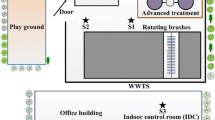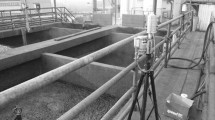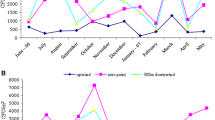Abstract
A field study was performed to identify the size distribution characteristics of viable, cultivable airborne microorganisms (heterotrophic bacteria, fungi, and total coliforms) at a municipal wastewater treatment facility, and their association with inhalable particulate matter (PM1, PM2.5, and PM10), as well as hydrogen sulfide concentrations and ambient meteorological parameters. The highest concentrations of cultivable, airborne heterotrophic bacteria, total coliforms, mass and number concentration of particulate matter, as well as hydrogen sulfide were observed at the aerated grit removal chambers at the pretreatment stage (3 to 2030 times higher than the values of the background ambient air). In contrast, the mean concentrations of cultivable, airborne mesophilic fungi at the aerated grit chambers were 0.6 time lower than the background site, where fungi presented the most abundant taxonomic group in the ambient air. Although the highest concentrations of the airborne fungi were determined at aerodynamic diameters between 2.1 and 3.3 μm, a nearly equal distribution of the mean concentrations of the cultivable, airborne heterotrophic bacteria were observed in the six different size fractions at the primary settling tanks and in the ambient air. Interestingly, their size distribution profiles at the aerated grit chambers were different and showed a maximum aerodynamic diameter at the size range from 3.3 to 4.7 μm, similar to that of the cultivable, airborne total coliforms. In general, low positive or no significant linear relationships could be found between the cultivable airborne heterotrophic bacteria, total coliforms, or fungi at the two wastewater treatment stages and the ambient background microbial community.





Similar content being viewed by others
References
Adhikari, A., Reponen, T., Grinshpun, S. A., Martuzevicius, D., & LeMasters, G. (2006). Correlation of ambient inhalable bioaerosols with particulate matter and ozone: A two-year study. Environmental Pollution, 140, 16–28.
American Public Health Association, American Water Works Association, Water Environment Federation. (1999). Standard methods for the examination of water and wastewater (20th ed.). New York: American Public Health Association.
Awad, A. H., & El Gendy, S. A. (2013). Evaluation of airborne Actinomycetes at waste application facilities. Atmospheric Pollution Research, 4, 1–7.
Bauer, H., Kasper-Giebl, A., Zibuschka, F., Hitzenberger, R., Kraus, F. G., & Puxbaum, H. (2002). Determination of the carbon content of airborne fungal spores. Analytical Chemistry, 74(1), 91–95.
Bertolini, V., Gandolfi, I., Ambrosini, R., Bestetti, G., Innocente, E., Rampazzo, G., et al. (2013). Temporal variability and effect of environmental variables on airborne bacterial communities in an urban area of Northern Italy. Applied Microbiology and Biotechnology, 97, 6561–6570. doi:10.1007/s00253-012-4450-0.
Brodie, E. L., DeSantis, T. Z., Moberg Parker, J. P., Zubietta, I. X., Piceno, Y. M., & Andersen, G. L. (2007). Urban aerosols harbor diverse and dynamic bacterial populations. Proceedings of the National Academy of Sciences of the United States of America, 104, 299–304.
Chalvatzaki, E., Kopanakis, I., Kontaksakis, M., Glytsos, T., Kalogerakis, N., & Lazaridis, M. (2010). Measurements of particulate matter concentrations at a landfill site (Crete, Greece). Waste Management, 11, 2058–2064.
Clauß, M. (2015). Particle size distribution of airborne micro-organisms in the environment—A review. Landbauforschung Applied Agricultural and Forestry Research, 65(2), 77–100. doi:10.3220/LBF1444216736000.
Cox, C. S., & Wathes, C. M. (1995). Bioaerosols handbook. USA: CRC Press Lewis Publishers.
Després, V. R., Huffman, J. A., Burrows, S. M., Hoose, C., Safatov, A. S., Buryak, G., et al. (2012). Primary biological aerosol particles in the atmosphere: A review. Tellus B, 64, 15598. doi:10.3402/tellusb.v64i0.15598.
Directive 2009/161/EU. (2009). Indicative occupational exposure limit values. http://eur-lex.europa.eu/legal-content/EN/TXT/HTML/?uri=CELEX:32009L0161&from=EN#ntr6-L_2009338EN.01008901-E0006.
Fierer, N., Liu, Z., Rodríguez-Hernández, M., Knight, R., Henn, M., & Hernandez, M. T. (2008). Short-term temporal variability in airborne bacterial and fungal populations. Applied and Environmental Microbiology, 74(1), 200–207.
Gomiscek, B., Hauck, Η., Stopper, S., & Preining, O. (2004). Spatial and temporal variations of PM1, PM2.5, PM10 and particle number concentration during the AUPHEP—Project. Atmospheric Environment, 38, 3917–3934.
Gotkowska-Plachta, A., Filipkowska, Z., Korzeniewska, E., Janczukowicz, W., Dixon, B., Golas, I., et al. (2013). Airborne microorganisms emitted from wastewater treatment plant treating domestic wastewater and meat processing industry wastes. Clean–Soil, Air, Water, 41(5), 429–436. doi:10.1002/clen.201100466.
Guo, X., Wu, P., Ding, W., Zhang, W., & Li, L. (2014). Reduction and characterization of bioaerosols in a wastewater treatment station via ventilation. Journal of Environmental Sciences, 26, 1575–1583.
Haas, D., Galler, H., Luxner, J., Zarfel, G., Buzina, W., Friedl, H., et al. (2013). The concentrations of culturable microorganisms in relation to particulate matter in urban air. Atmospheric Environment, 65, 215–222.
Hinds, W. C. (1999). Aerosol technology. New York: Wiley-Interscience.
Hsiao, P.-K., Cheng, C.-C., Chang, K.-C., Yiin, L.-M., Hsieh, C.-J., & Tseng, C.-C. (2014). Performance of CHROMagar VRE medium for the detection of airborne vancomycin-resistant/sensitive Enterococcus species. Aerosol Science and Technology, 48, 173–183.
Hubad, B., & Lapanje, A. (2013). The efficient method for simultaneous monitoring of the culturable as well as nonculturable airborne microorganisms. PLoS ONE, 8(12), e82186. doi:10.1371/journal.pone.0082186.
Hughes, K. A. (2003). Aerial dispersal and survival of sewage-derived faecal coliforms in Antarctica. Atmospheric Environment, 37, 3147–3155.
Hung, L.-L., Miller, J.D., & Dillon, H.K. (2005). Field guide for the determination of biological contaminants in environmental samples (2nd edn.). Fairfax, Virginia, U.S.A.: American Industrial Hygiene Association (AIHA), AIHA Press.
Hung, H. F., Kuo, Y. M., Chien, C. C., & Chen, C. C. (2010). Use of floating balls for reducing bacterial aerosol emissions from aeration in wastewater treatment processes. Journal of Hazardous Materials, 175, 866–871.
Jaenicke, R. (2005). Abundance of cellular material and proteins in the atmosphere. Science, 308, 73.
Jones, A. M., & Harrison, R. M. (2004). The effects of meteorological factors on atmospheric bioaerosol concentrations—A review. Science of the Total Environment, 326, 151–180.
Karbowska-Berent, J., Gorny, R. L., Strzelczyk, A. B., & Wlazlo, A. (2011). Airborne and dust borne microorganisms in selected Polish libraries and archives. Building and Environment, 46, 1872–1879.
Karra, S., & Katsivela, E. (2007). Microorganisms in bioaerosol emissions from wastewater treatment plants during summer at a Mediterranean site. Water Research, 41, 1355–1365.
Korzeniewska, E. (2011). Emission of bacteria and fungi in the air from wastewater treatment plants—A review. Frontiers in Bioscience (Scholar Edition), 3(2), 303–407.
Lazaridis, M., Katsivela, E., Kopanakis, I., Raisi, L., & Panagiaris, G. (2015). Indoor/outdoor particulate matter concentrations and microbial load in cultural heritage collections. Heritage Science, 3, 34. doi:10.1186/s40494-015-0063-0.
Li, M., Qi, J., Zhang, H., Huang, S., Li, L., & Gao, D. (2011). Concentration and size distribution in an outdoor environment in the Qingdao coastal region. Science of the Total Environment, 409, 3812–3819.
Li, Y., Yang, L., Meng, Q., Qui, X., & Feng, Y. (2013). Emission characteristics of microbial aerosols in a municipal sewage treatment plant in Xi’an, China. Aerosol and Air Quality Research, 13, 343–349.
Maharia, S., & Srivastava, A. (2014). Influence of seasonal variation on concentration of fungal bioaerosol at a sewage treatment plant (STP) in Dehli. Aerobiologia, 31(2), 249–260. doi:10.1007/s10453-014-9361-3.
Malakootian, M., Radhakrishna, N., Mazandarany, M. P., & Hossaini, H. (2013). Bacterial aerosol emission from wastewater treatment plant. Desalination and Water Treatment, 51, 4478–4488.
Mandrioli, P., Caneva, G., & Sabbioni, C. (2004). Cultural heritage and aerobiology—Methods and measurement techniques for biodeterioration monitoring. Berlin: Springer.
Masclaux, F. G., Hotz, P., Gashi, D., Savona-Bianchi, D., & Opplinger, A. (2014). Assessment of airborne virus contamination in wastewater treatment plants. Environmental Research, 133, 260–265.
Matthias-Maser, S., Obolkin, V., Khodzer, T., & Jaenicke, R. (2000). Seasonal variation of primary biological aerosol particles in the remote continental region of Lake Baikal/Siberia. Atmospheric Environment, 34, 3805–3811.
McDonald, J. H. (2014). Handbook of biological statistics (3rd ed.). Baltimore: Sparky House Publishing.
Oliveira, M., Ribeirio, H., Delgado, J. L., & Abreu, I. (2009). The effects of meteorological factors on airborne fungal spore concentration in two areas differing in urbanisation level. International Journal of Biometeorology, 53, 61–73.
Pascual, L., Perez-Luz, S., Adela Yanez, M., Santamaria, A., Gibert, K., Salgot, M., et al. (2003). Bioaerosol emission from wastewater treatment plants. Aerobiologia, 19, 261–270.
Polymenakou, P. N., Mandalakis, M., Stephanou, E. G., & Tselepides, A. (2008). Particle size distribution of airborne microorganisms and pathogens during an intense African dust event in the Eastern Mediterranean. Environmental Health Perspectives, 116, 292–296.
Pyrri, I., & Kapsanaki-Gotsi, E. (2012). Diversity and annual fluctuations of cultivable airborne fungi in Athens, Greece: A 4-year study. Aerobiologia, 28(2), 249–262. doi:10.1007/s10451-011-9233-z.
Raisi, L., Aleksandropoulou, V., Lazaridis, M., & Katsivela, E. (2013). Size distribution of viable, cultivable airborne microbes and their relationship to particulate matter concentrations and meteorological conditions in a Mediterranean site. Aerobiologia, 29(2), 233–248. doi:10.1007/s10453-012-9276-9.
Raisi, L., Lazaridis, M., & Katsivela, E. (2010). Relationship between airborne microbial and particulate matter concentrations in the ambient air at a Mediterranean site. Global Nest Journal, 12(1), 84–91.
Ranalli, G., Principi, P., & Sorlini, C. (2000). Bacterial aerosol emission from wastewater treatment plants: Culture methods and bio-molecular tools. Aerobiologia, 16, 39–46.
Ross, C., de Menezes, J. R., Svidzinski, T. I. E., Albino, U., & Andrade, G. (2004). Studies on fungal and bacterial population of airconditioned environments. Brazilian Archives of Biology and Technology, 47(5), 827–835.
Saldanha, R., Manno, M., Saleh, M., Ewaze, J. O., & Scott, J. A. (2008). The influence of sampling duration on recovery of viable fungi using the Andersen N6 and RCS Biotest bioaerosol samplers. Indoor Air, 18, 464–472.
Seifried, J. S., Wichels, A., & Gerdts, G. (2015). Spatial distribution of marine airborne bacterial communities. Microbiologyopen, 4(3), 475–490. doi:10.1002/mbo3.253.
Singh, J., Knapp, H. V., & Demissie, M. (2004). Hydrologic modeling of the Iroquois River watershed using HSPF and SWAT. ISWS CR 2004-08. Champaign, IL: Illinois State Water Survey. www.sws.uiuc.edu/pubdoc/CR/ISWSCR2004-08.pdf.
Sommer, B., Marino, A., Solarte, Y., Salas, M., Dierolf, L. C., Valiente, C., et al. (1997). SODIS—An emerging water treatment process. Journal of Water Supply: Research and Technology-AQUA, 46(3), 127–137.
Stelzenbach, L. D. (2002). Introduction to aerobiology. In C. J. Hurst et al. (Eds.), Manual of environmental microbiology (pp. 801–813). Washington, DC: ASM Press.
Tchobanoglous, G., Burton, F. L., & Stensel, H. D. (2003). Wastewater engineering (4th ed.). New York: Metcalf & Eddy, McGraw-Hill.
Thermo ESM Andersen Instruments GmbH. (2003). Operating manual, particulate monitoring instrument, FH 62 I-R.
Urbano, R., Palenik, B., Gaston, C. J., & Prather, K. A. (2011). Detection and phylogenetic analysis of coastal bioaerosols using culture depended and independent techniques. Biogeosciences, 8, 301–309.
Willmott, C. J. (1981). On the validation of models. Physical Geography, 2, 184–194.
Willmott, C. J. (1982). Some comments on the evaluation of model performance. Bulletin American Meteorological Society, 63, 1309–1313.
Acknowledgements
The research leading to these results has received funding from the European Union Seventh Framework Programme HEXACOMM FP7/2007-2013 under Grant Agreement No. 315760. The authors want to thank the Municipal Enterprise for Water and Sewage of Chania (Crete, Greece) (DEYACH) for the permission of air sampling at the Municipal Wastewater Treatment Plant of Chania. In particular, we thank the chemical engineer C. Kotsifaki and her co-workers in the Municipal Wastewater Treatment Plant of Chania for her kindly help.
Author information
Authors and Affiliations
Corresponding author
Electronic supplementary material
Below is the link to the electronic supplementary material.
Rights and permissions
About this article
Cite this article
Katsivela, E., Latos, E., Raisi, L. et al. Particle size distribution of cultivable airborne microbes and inhalable particulate matter in a wastewater treatment plant facility. Aerobiologia 33, 297–314 (2017). https://doi.org/10.1007/s10453-016-9470-2
Received:
Accepted:
Published:
Issue Date:
DOI: https://doi.org/10.1007/s10453-016-9470-2




